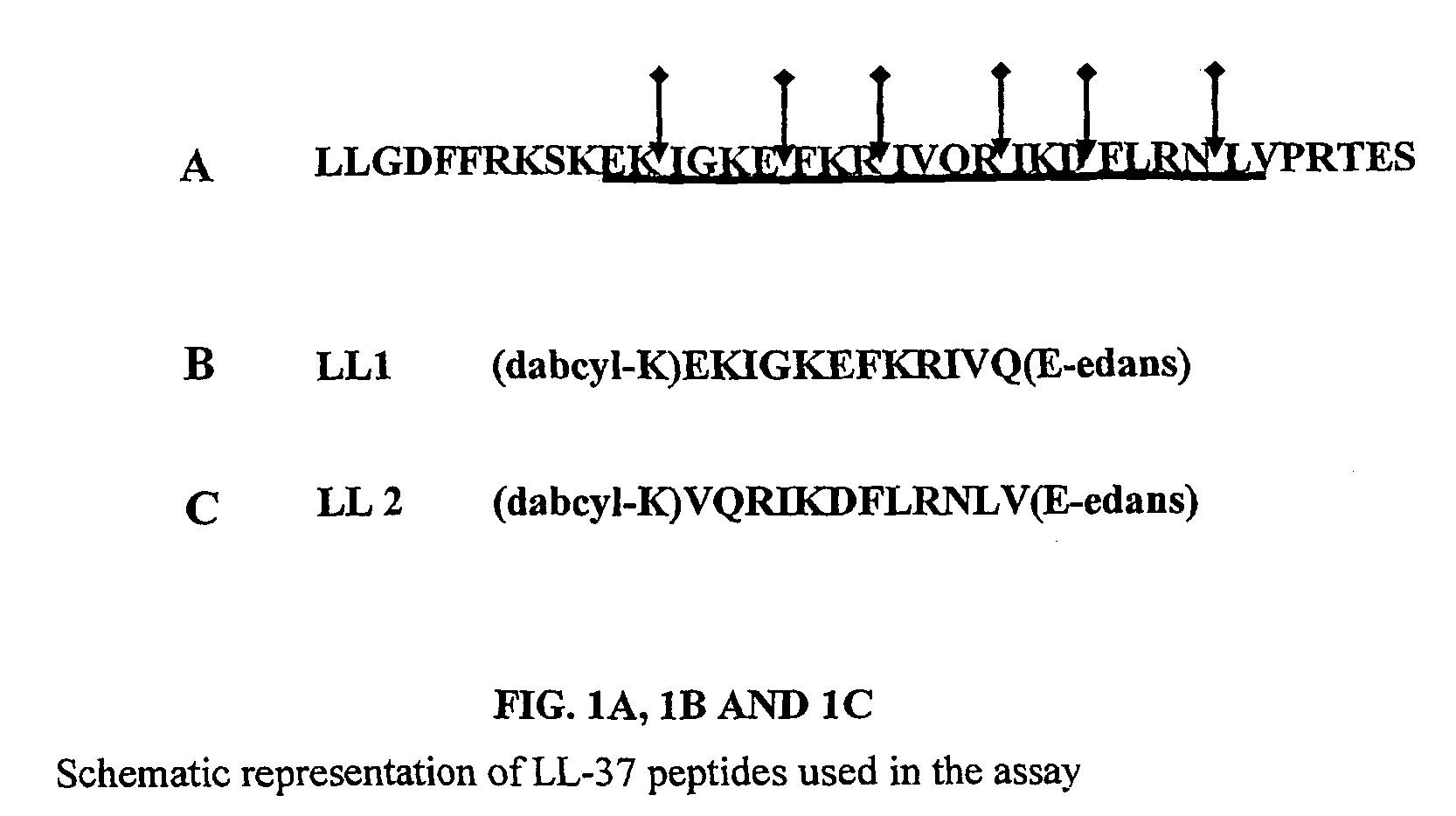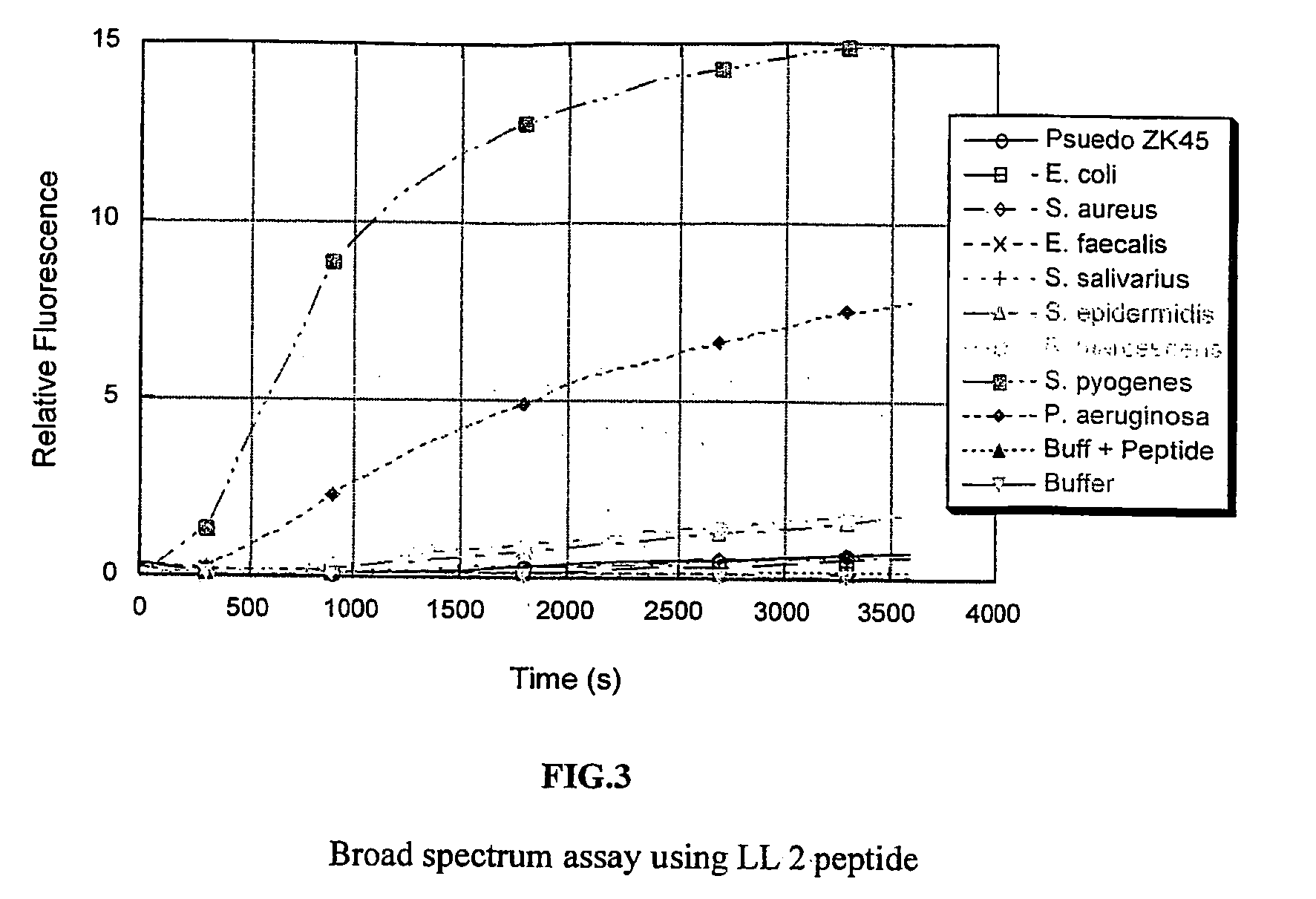Cationic anti-microbial peptides and methods of use thereof
a technology of cationic antimicrobial peptides and peptides, which is applied in the field of cationic antimicrobial peptides and, can solve the problems of unintended effect of breeding resistant strains of bacteria, severe, even life-threatening infection in the human host, and many symptoms only apparen
- Summary
- Abstract
- Description
- Claims
- Application Information
AI Technical Summary
Benefits of technology
Problems solved by technology
Method used
Image
Examples
example 1
Detection Assays
[0063] Two peptide substrates, LL 1 and LL 2, were synthesized so as to encompass all the cleavage sites of the LL-37 as shown in FIGS. 1A, 1B& C. The peptide substrates used here were labeled with the fluorescent probe edans (5-((2-aminoethyl)amino)naphthalene-1-sulphonice acid) and the quencher dye molecule dabcyl((4-(4-(dimethylamino)phenyl)azo)benzoic acid).
[0064] The bacteria were grown in an incubator overnight at 37 C in 5 ml BHI (Brain Heart Infusion) media. Each of the resulting cultures was split into two samples. One was used as is, and the other was spun down and the supernatant was collected. The assays were run in 20 mM tris buffer (pH 7.4) with 150 mM NaCl added. The reaction was carried out with 7 ul of culture or supernatant and 3 ul peptide substrate (5 mg / ml in water) in 100 ul total volume at 37 C. The reaction was followed on a fluorimetric plate reader using an excitation wavelength of 355 nm and an emission wavelength of 485 nm.
[0065] The fi...
example 2
Porcine Wound Fluid Assay
[0071] In order to test for cross reactivity in a wound, the assays were performed under physiologically relevant conditions. The assay for LL1 and LL2 were tested using porcine wound fluid extract in place of reaction buffer.
[0072] Immediately after surgery to create partial thickness wounds for the sensor study a gauze dressing was placed on the wound. After a time the dressing was removed, bagged, and placed in a freezer at −80 C. Absorbed wound fluid was recovered from the dressing by incubation in 10 mls buffer (0.1M Tris-HCl, pH 7.4 with 0.1% Triton X-100). The dressing was incubated on both sides for 2 hours at room temperature and squeezed out. The fluid obtained was aliquoted out and frozen at −20 C.
[0073] The bacteria were grown in an incubator overnight at 37 C in 5 ml BHI (Brain Heart Infusion) media. Each of the resulting cultures was spun down and the supernatant was collected. The assays were run in freshly thawed wound fluid. The reaction ...
PUM
| Property | Measurement | Unit |
|---|---|---|
| with wavelength | aaaaa | aaaaa |
| with wavelength | aaaaa | aaaaa |
| pH | aaaaa | aaaaa |
Abstract
Description
Claims
Application Information
 Login to View More
Login to View More - R&D
- Intellectual Property
- Life Sciences
- Materials
- Tech Scout
- Unparalleled Data Quality
- Higher Quality Content
- 60% Fewer Hallucinations
Browse by: Latest US Patents, China's latest patents, Technical Efficacy Thesaurus, Application Domain, Technology Topic, Popular Technical Reports.
© 2025 PatSnap. All rights reserved.Legal|Privacy policy|Modern Slavery Act Transparency Statement|Sitemap|About US| Contact US: help@patsnap.com



